| Author |
Topic: Pull Release Mechanism |
Jim Bob Sedgwick
From:
Clinton, Missouri USA
|
 Posted 27 Mar 2011 8:55 am
Posted 27 Mar 2011 8:55 am |
|
For Richard Burton.... I was looking at your drawing of the pull release system you used on one of your guitars. I just have a question... When the changer is at rest position, the spring seems to be the only stop involved. Did you have a problem with the changer not coming to rest each time at the same place upon release?
It seems to be somewhat comparable to the old Bigsby tremolo on standard guitars. They never seemed to stop at the same place twice, and were a PIA to keep in tune.
Did you use an extra heavy duty compression spring to solve this problem? Just curious. |
|
|
 |
richard burton
From:
Britain
|
|
|
 |
Jim Bob Sedgwick
From:
Clinton, Missouri USA
|
 Posted 27 Mar 2011 5:30 pm
Posted 27 Mar 2011 5:30 pm |
|
Thanks Richard. I also note the spring is a regular spring, not a compression spring. This should work
Very well. Does this method limit the number of raises and lowers? |
|
|
 |
richard burton
From:
Britain
|
 Posted 27 Mar 2011 8:57 pm
Posted 27 Mar 2011 8:57 pm |
|
| It's just like a push-pull, with the single raise rod going through as many bellcranks as is practical, eg the fourth string raise goes through the F lever bellcrank, and then onto the C pedal bellcrank |
|
|
 |
Jim Bob Sedgwick
From:
Clinton, Missouri USA
|
 Posted 28 Mar 2011 9:14 am
Posted 28 Mar 2011 9:14 am |
|
| Thanks for the information Richard. I appreciate your time and effort. |
|
|
 |
Miroslav Jílek
From:
Czech Republic
|
 Posted 29 Mar 2011 12:18 am
Posted 29 Mar 2011 12:18 am |
|
| Hi Richard, can you explane me, what´s a difference between the push-pull and the pull - release system ?Which one of them sounds like better? Thanks Miroslav |
|
|
 |
richard burton
From:
Britain
|
 Posted 29 Mar 2011 1:29 pm
Posted 29 Mar 2011 1:29 pm |
|
The push-pull and pull-release changers are very similar, and totally unlike the all-pull system.
The push-pull is slightly more advanced than the pull-release, in that nearly all the tuning is done at the headstock and the endplate, whilst the pull-release has a bit more tuning done on the underside.
I have recorded my Emmons push-pull and my Marlen pull-release, and can't tell which is which. |
|
|
 |
Ken Byng
From:
Southampton, England
|
 Posted 29 Mar 2011 2:05 pm
Posted 29 Mar 2011 2:05 pm |
|
| richard burton wrote: |
| I have recorded my Emmons push-pull and my Marlen pull-release, and can't tell which is which. |
Yes Richard, but which one has got the best fretboard? 
_________________
Show Pro D10 - amber (8+6), MSA D10 Legend XL Signature - redburst (9+6), Sho-Bud Pro 111 Custom (8+6), Emmons black Push-Pull D10 (8+5), Zum D10 (8x8), Hudson pedal resonator. Telonics TCA-500, Webb 614-E, |
|
|
 |
Ned McIntosh
From:
New South Wales, Australia
|
 Posted 2 Apr 2011 2:08 am
Posted 2 Apr 2011 2:08 am |
|
Pull release is an old system which is simple to understand but very sensitive to spring-tension and un-necessary friction or binding of parts in the mechanism. Adjusting it requires a full understanding of how the raises occur, and how to balance a string at the open note if it is both raised and lowered.
It is simpler than push-pull because it uses a one-piece changer-finger. It tunes more or less like a push-pull; raises at the keyhead with pedal/lever engaged, lowers tuned at stop-screws at the endplate with pedal/lever engaged and the open-note at the changer-finger itself, usually with a nylon tuning-nut working aganst string-tension and any return-spring tension if return-springs are used.
Any binding of a rod against another rod, or a cross-shaft, is a recipe for frustration. Also, if a pedal or lever doesn't disengage fully, you will probably have trouble tuning an open-note. The mechanism Richard diagrammed above is one way of tuning the open note (and one I quite like), but later Marlens (to take just one example) use the nylon-tuning nut at the changer-finger, threaded onto a return-rod with a spring attached to it at the other end to add tension...and before tuning-nuts they used stop-collars clamped onto the end of the rods with grub-screws. These took some adjusting to get just right, especially if you inadvertantly changed string-gauges!
Nothing is inherently wrong with pull-release, but it is an old system and not as versatile as the all-pull changer. It is very reliable and stable once set up and the tone of those old Marlens is something else in the hands of a skilled player.
Here are some photographs:-
First, these two collars (slightly out-of-focus) are on the tension rods for the two E-strings. The bellcrank pushes them (towards bottom left of the pic) when activated, reducing the tension and allowing the Es to lower to Eb. Small tabs on the collars fit in the middle of the bellcrank to prevent the rod rotating when the nylon tuning-nut is adjusted (very important!)
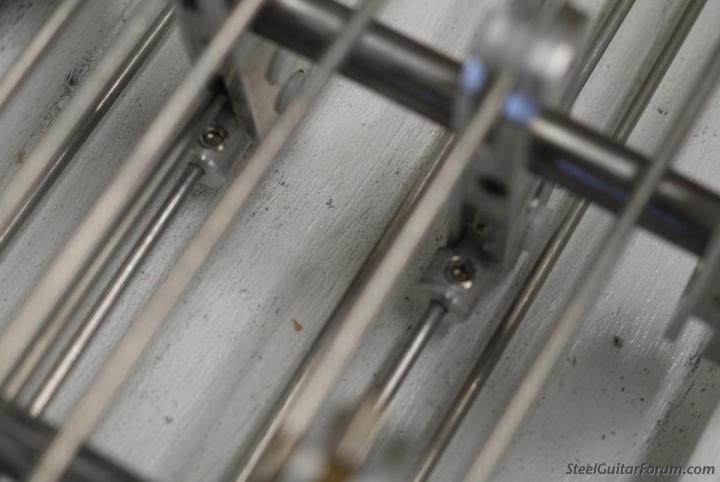
Here, at the other end of the steel, are the tension springs attached to the rods for lowering. (The adjustment mechanism is borrowed from forum member Harry Sheppard.) Note how both necks use the same system for tension-rods.
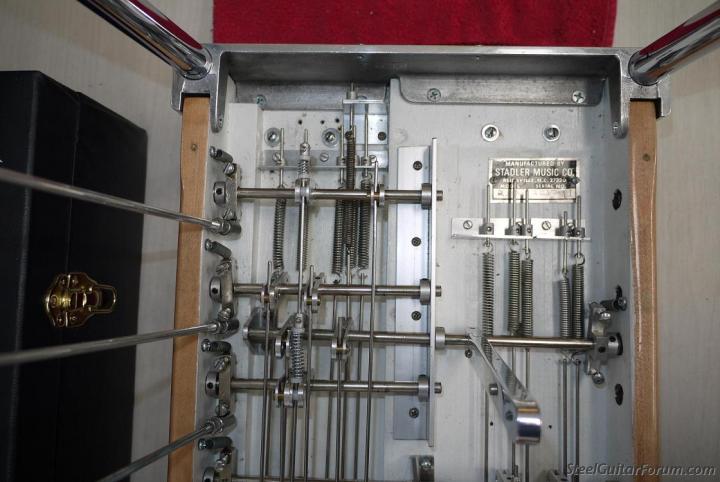
The next photo is a shot of a pull-release E9th changer from below, showing the rods, stop-collars and tuning-nuts. Note the short-throw of the lever for lowering strings 2 and 9 doesn't need a tension-rod and a return spring...they just push the finger back against string-tension. (The 1st string is at left.)

and finally, here is a view of the E9th pull-release changer from the side. The bends in the rods are to ensure no rod binds against a cross-shaft. (As the C6th changer sits lower, these bends are not required because all the rods will clear the shafts anyway.) Visible are a couple of brass rod-clamps and a white Delrin rod-guide in a bellcrank hole, stabilising a long rod so it doesn't rattle or accidentally bind against another part of the mechanism. The small springs on the 2nd and 9th string lowers add feel - and I need to add a small Delrin washer to the 9th string lower to cushion the spring against the changer-finger. Also note these changer-fingers are 4-hole units, later Marlen went to a 6-hole changer-finger.
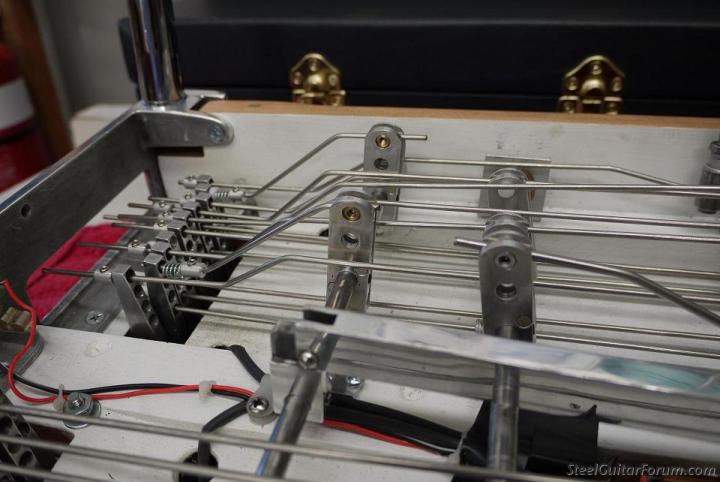
Please note this mechanism isn't the same as Richard's diagram as there is no reaching under the guitar to tune the open-note...that is done at the changer-finger by the nylon nut. Hope this helps folks to understand how this very simple changer works and why it is so sensitive to friction and spring-tension.
_________________
The steel guitar is a hard mistress. She will obsess you, bemuse and bewitch you. She will dash your hopes on what seems to be whim, only to tease you into renewing the relationship once more so she can do it to you all over again...and yet, if you somehow manage to touch her in that certain magic way, she will yield up a sound which has so much soul, raw emotion and heartfelt depth to it that she will pierce you to the very core of your being. |
|
|
 |
Ned McIntosh
From:
New South Wales, Australia
|
 Posted 10 Apr 2011 2:12 am
Posted 10 Apr 2011 2:12 am |
|
Adding some more pictures, for those who are interested:-
First, the return-springs and bellcranks at the E9th pedals. Every string which has a lower, or a raise and lower, needs a return-spring and rod to the changer. If it is a raise-only string, then the changer-finger sits on the endplate stop-screw and is pulled by the rod to raise, working against string-tension only. Rigging and tuning a raise-only on a pull-release is a snack!
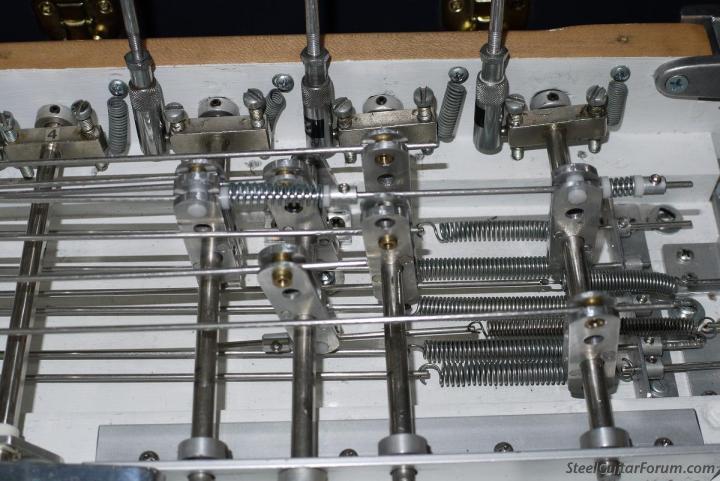
A shot of the E9th changer from below shows the slack necessary in the raise-rods to allow the lowers to take place, just like an Emmons. The nylon tuning-nuts, visible below the raise-rod stop-collars, tune the open note for a string that raises and lowers. You can see everything in a pull-release changer!
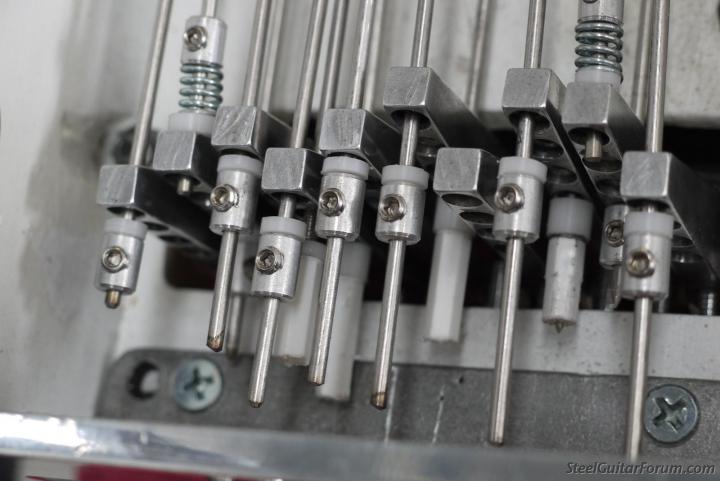
If at all possible, straight runs of rods help minimise friction and binding. You don't want excess friction or binding in this system! In the photo below, a small white Delrin bush supports a long rod which doesn't run through a bellcrank, preventing it from rattling or sagging (lower middle of picture).
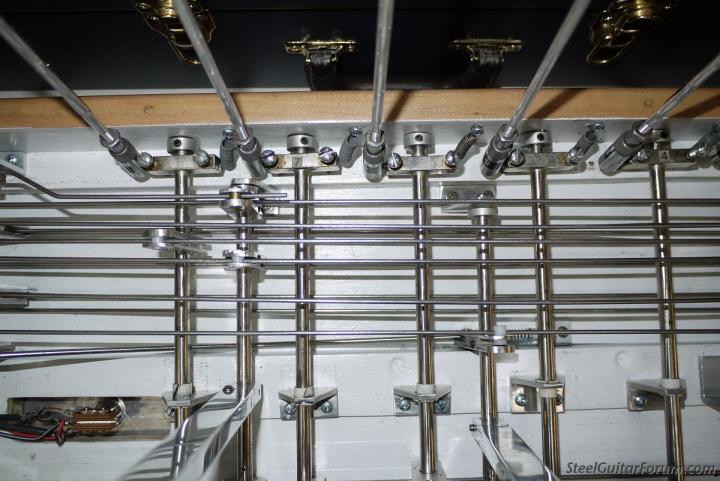
The 6th string-lower also has a rod back to the keyhead end to completely disengage the lower because there wasn't enough room to put a spring on the cross-shaft...so we pull the bellcrank back instead. Visible below is the aluminium stop-collar on the tension-rod which is pushed by the bellcrank to achieve the lower, and above it is the brass rod-clamp for the rod that runs to the return-spring at the keyhead end, bringing the bellcrank back to battery.
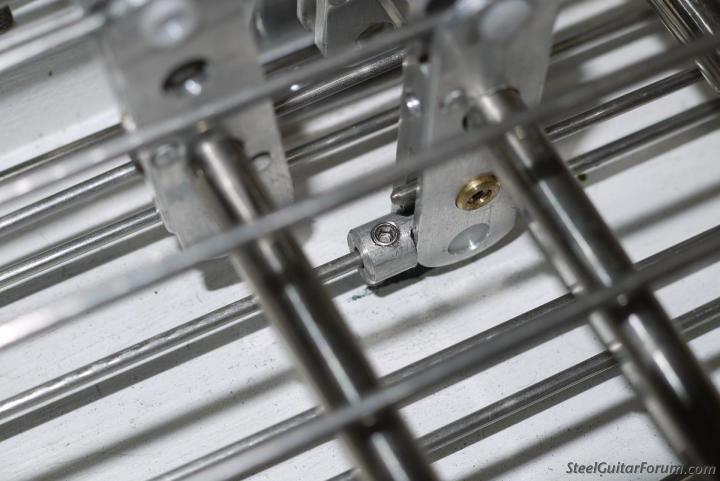
Again at the 6th-string lower, at the keyhead end we have the spring that drags the bellcrank back. It's the left-most of the top two springs visible.
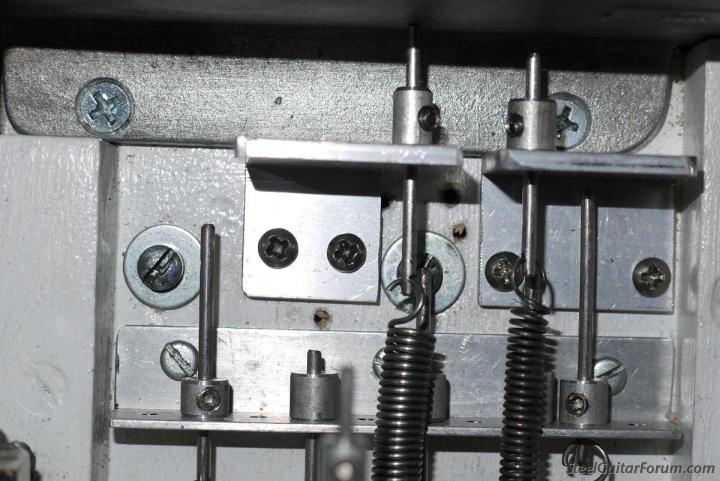
And to illustrate the beauty of Len Statler's cabinets, here is a shot of this pull-release Marlen from the side the audience normally sees!
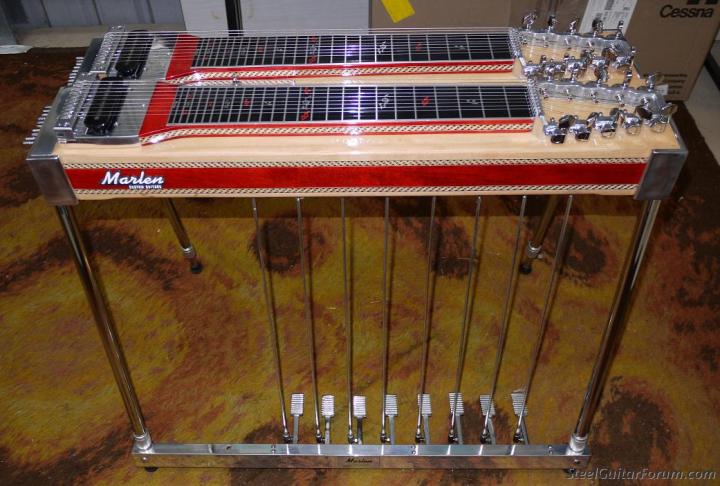
The output of the pickups is slighty lower than the modern units (weaker magnets back in the 70s??) but the tone is magnificent!
_________________
The steel guitar is a hard mistress. She will obsess you, bemuse and bewitch you. She will dash your hopes on what seems to be whim, only to tease you into renewing the relationship once more so she can do it to you all over again...and yet, if you somehow manage to touch her in that certain magic way, she will yield up a sound which has so much soul, raw emotion and heartfelt depth to it that she will pierce you to the very core of your being. |
|
|
 |
Allan Munro
From:
Pennsylvania, USA and Scotland
|
 Posted 11 Apr 2011 7:12 am
Posted 11 Apr 2011 7:12 am |
|
Ned, excellent set of pictures. Thank you for posting them. Cleared up a lot of things in my mind regarding the practicalities. I understood the concepts and now I have a grasp of the 'how it goes together' side of things.
Regards, Allan.....
_________________
Only nuts eat squirrels.
Television is the REAL opiate of the masses! |
|
|
 |
Michael Hutchison
From:
Indianapolis, USA
|
 Posted 20 Sep 2011 12:12 pm
Posted 20 Sep 2011 12:12 pm |
|
Old thread, sorry... but I'm curious:
Those pull rods with the bend in them - does the string tension tend to straighten the rod over time, and are there issues with the pull being the same pitch every time? |
|
|
 |
Ned McIntosh
From:
New South Wales, Australia
|
 Posted 20 Sep 2011 10:07 pm
Posted 20 Sep 2011 10:07 pm |
|
Hi Michael,
The bent rods are not subjected to enough stress to straighten out over time. Mine are 2.4mm stainless-steel welding-rod, whch is very, very close in diameter to the rods Carter and Williams use. Mullen use a slightly thicker rod, and as for other brands I am sure there are many who know the diameters of the rods used.
As far as pulls varying, each pull stops when a stop-screw hits the cabinet...end of mechanical action. The raise is tuned at the keyhead tuning-machine with the pull engaged fully to the stop. The distance of travel is fixed and repeatable.
You need to make sure all the stretch is out of the string before you tune it, same as any steel-guitar. Once the string is fully stretched, and the stop-screw is properly set, then the notes raise true and return true.
The trick is balancing string-tension and spring-tension on strings that both raise and lower, such as the Es and the G# (6th string). When you change one variable (such as adjusting the return spring-tension) you change everything else and you have to re-tune the raise and the lower and the open-note, and you need to keep adjusting each and every one of them until all three are true and repeatable. Unless the return-spring tension is correct, this can have you tearing your hair out....not dis-similar to an Emmons push-pull until you get to know precisely how the mechanism works,what must take precedence over what, and where to add the slack etc etc etc.
Getting the return-spring tension just right is perhaps the most frustrating thing, but once it is correct then the raise and lower and open-note will hold their tuning. Once all three are set, provided you stick to the same gauge string, it rarely needs anything but the most minor adjustment when a new string is fitted.
Pull-release is simple but heavily dependent on precise adjustments of spring and string-tension. A raise-only or a lower-only is child's play to set up. A string that does both needs balanced tensions...and once they are all balanced then ths string will behave properly.
Every part of the changer can be seen, making it a snack to trouble-shoot but you must get those tensions properly balanced before the steel will hold stable tuning. Once the balance is achieved, these steels are very stable in tuning...and they have tone which is distinctive and very, very pleasing. They also have a different playing feel to the all-pull steels.
_________________
The steel guitar is a hard mistress. She will obsess you, bemuse and bewitch you. She will dash your hopes on what seems to be whim, only to tease you into renewing the relationship once more so she can do it to you all over again...and yet, if you somehow manage to touch her in that certain magic way, she will yield up a sound which has so much soul, raw emotion and heartfelt depth to it that she will pierce you to the very core of your being. |
|
|
 |
Clete Ritta
From:
San Antonio, Texas
|
 Posted 21 Sep 2011 12:30 am Re: Pull Release Mechanism
Posted 21 Sep 2011 12:30 am Re: Pull Release Mechanism |
|
Great thread, and thanks for your posts Ned. Your pictures are worth a kiloword apiece and your word is worth two...very informative... to a newby like me!
| Jim Bob Sedgwick wrote: |
| ...It seems to be somewhat comparable to the old Bigsby tremolo on standard guitars. They never seemed to stop at the same place twice, and were a PIA to keep in tune... |
I have a Firebird VII which looks, sounds and plays wonderfully...until you use the tremolo.  Its not a Bigsby, just a bent metal plate. The fixed bridge isnt so fixed and the plastic nut holds more string tension from the reverse headstock too, but a roller bridge and tusq nut are on the way. The newer floating "edge" tremolos are extremely precise and accurate, and in some ways remind me of the balancing act of the older push pull tuning described above. Its not a Bigsby, just a bent metal plate. The fixed bridge isnt so fixed and the plastic nut holds more string tension from the reverse headstock too, but a roller bridge and tusq nut are on the way. The newer floating "edge" tremolos are extremely precise and accurate, and in some ways remind me of the balancing act of the older push pull tuning described above.
Clete |
|
|
 |




